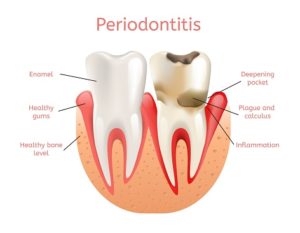
Swollen and bleeding gums are early signs that bacteria have infected your gums. Periodontal disease is caused by bacterial plaque buildup. Sometimes the bleeding and swelling might not cause pain or discomfort, but if the infection is not treated, the infection can spread. When the infection spreads, it can destroy the bone and gum tissue that supports your teeth. It is not necessarily the bacteria that destroys the tissue and teeth. It is the immune system’s response that causes inflammation that eventually destroys the gums, soft tissues, and bone structures. The swollen and bleeding gum is a result of inflammation. The swelling and gum tissue recession cause the gum tissue to begin to separate from the teeth. Gum recession leaves large space between the tooth and gums where bacteria can grow.
How is periodontal disease diagnosed?
Signs of periodontal diseases are swollen and bleeding gum. However, swollen and bleeding gum might not necessarily indicate that you have periodontal diseases. One of the simplest and effective diagnostic methods your dentist will use is to measure the periodontal pockets or the gap between the gum and teeth. A periodontal probe is used to rank the severity of the diseases. The periodontal pockets are the space around the teeth below the gum line that is infected. A periodontal probe measures this gap during an examination. When your dentist measures the periodontal pockets, you will hear the dentist rank the pockets from 1 to 10. The periodontal pockets are ranked in millimeters (mm). Higher periodontal pocket ranks indicate progressing severity of the diseases, and lower ranks indicate less severe disease progression.
Meaning of periodontal pocket ranks:
1-3 mm indicates normal space below the gum tissue.
3-5 mm shows early signs of periodontal disease.
5-7 mm indicates mild to moderate periodontal disease.
7-10 mm indicates severe periodontal disease.
How is periodontal disease treated?
There is no one size fits all when it comes to treating periodontal disease. Since every periodontal pocket comes in different size and severity, the treatment course will depend on the depth and shape of the pocket. Treatment can be complicated if the pockets are deep, and bone loss is severe. Based on these factors, your dentist will recommend the best course of treatment to save the teeth or reverse gum diseases. Periodontal disease treatment may require therapies such as:
Scaling: Removal of plaque beneath the gum and surface of the tooth.
Root planning: Root planning smooths root surfaces to reduce tartar and bacteria buildup to reduce future buildup.
Antibiotics: Topical or oral antibiotics used to help control bacterial infection of the gums.
Surgery: Incision of sections of the gum to allow effective scaling.
Bone grafting: Bone grafting uses healthy bone tissue to promote bone regeneration.
Ideally, after these treatments, the bacteria in the pockets will be removed, and with proper hygiene and regular visits to your dentist, the gums will remain healthy. If you have concerns about the health of your gums, please give California Dental Group a call at 800-407-0161 to make your appointment.

